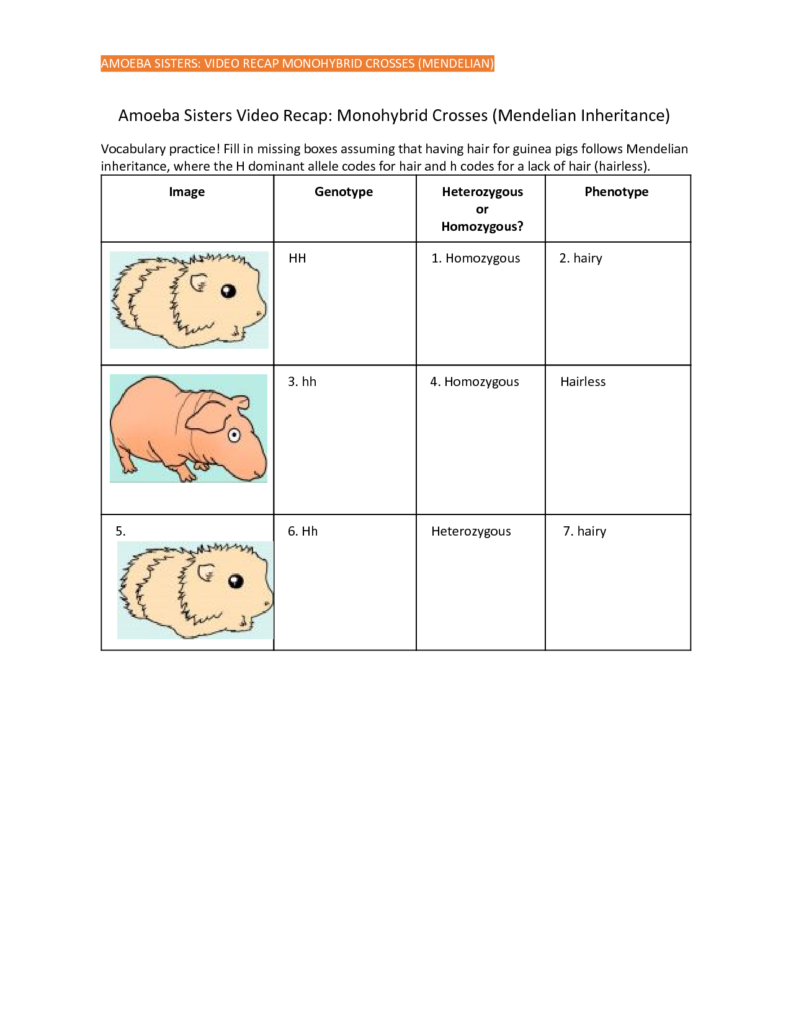Welcome to Classical Genetics!
>CONTENTS: Mendelian Genetics
- Key Terms in Genetics
- Mendelian Laws
- Monohybrid Crosses
- Dihybrid Crosses
- Phenotypic Variation
>CONTENTS: Non-Mendelian Genetics & Chromosomal Inheritance
- Introduction
- Linked Genes
- Sex-Linked Genes
- Codominance
- Multiple Alleles & Epistasis
- Non-Nuclear Inheritance
- Chi-Squared Test
- Chromosomal Theory of Inheritance
- Chromosomal Basis of Inheritance
Session One – Mendelian Genetics
>>Key Terms in Genetics
| Gene | Genes are the building blocks of inheritance, containing instructions for making proteins. |
| Gamete | A gamete is a reproductive cell of an animal or plant. In animals, female gametes are called ova or egg cells, and male gametes are called sperm. |
| Allele | Alleles are different forms of a gene. They can vary in sequence and contribute to genetic diversity. |
| DNA | The DNA is a molecule that contains the genetic instructions for the development, functioning, growth, and reproduction of all known organisms. It is made up of two strands that coil around each other to form a double helix. |
| Diploid | Diploid refers to cells with two sets of chromosomes. In humans, this means having 46 chromosomes, with 23 inherited from each parent. |
| Haploid | Ova and sperm are haploid gametes. They have 23 chromosomes in humans. |
| Chromosome | A structure found inside the nucleus of a cell. A chromosome is made up of proteins and DNA organized into genes. Each cell normally contains 23 pairs of chromosomes. |
| Genotype | The genetic makeup of an organism or group of organisms with reference to a single trait, set of traits, or an entire complex of traits. |
| Phenotype | The phenotype is the observable characteristics of an organism, influenced by both genetic and environmental factors. It’s an observable type of an organism, and it can refer to anything from a common trait, such as height or hair color, to presence or absence of a disease. |
| Dominant and Recessive | A dominant allele produces a dominant phenotype in individuals who have one copy of the allele, which can come from just one parent. For a recessive allele to produce a recessive phenotype, the individual must have two copies, one from each parent. An individual with one dominant and one recessive allele for a gene will have the dominant phenotype. They are generally considered “carriers” of the recessive allele: the recessive allele is there, but the recessive phenotype is not. |
| Co-dominant | The term “co-dominant” refers to a genetic scenario where two different versions of a gene are equally expressed and neither allele is dominant or recessive. |
| Heterozygote | Heterozygote refers to having two different alleles for a specific gene. This can influence traits and disease risk. Some alleles are dominant, while others are recessive. Heterozygous individuals can carry a recessive allele without expressing the associated trait. |
| Homozygote | Homozygous refers to having two identical alleles for a specific gene. This can result in the expression of a particular trait or disease. For example, in Huntington’s disease, homozygosity can lead to a more severe clinical course. However, not all homozygous traits or diseases are more severe than their heterozygous counterparts. |
Complete – Key Terms in Genetics
Mendelian Laws
Mendel’s laws of inheritance include law of dominance, law of segregation and law of independent assortment.
Law of Dominance
Hybrid offspring will only inherit the dominant trait in the phenotype. The alleles that are suppressed are called the recessive traits while the alleles that determine the trait are known as the dominant traits.
Law of Segregation
During the production of gametes, two copies of each hereditary factor segregate so that offspring acquire one factor from each parent. Allele (alternative form of the gene) pairs segregate during the formation of gamete and re-unite randomly during fertilization.
Law of Independent Assortment
A pair of traits segregates independently of another pair during gamete formation. As the individual heredity factors assort independently, different traits get equal opportunity to occur together.
(adapted from: https://byjus.com/biology/mendel-laws-of-inheritance/#:~:text=Mendel’s%20laws%20of%20inheritance%20include,and%20law%20of%20independent%20assortment)
Complete – Mendelian Laws
Monohybrid Crosses
Monohybrid Cross Example
Gregor Mendel’s Peas
For monohybrid cross, Mendel began with a pair of pea plants with two contrasting traits, i.e… one tall and another dwarf. The cross-pollination of tall and dwarf plants resulted in tall plants. All the hybrid plants were tall. He called this first progeny the first hybrid generation.
He continued his experiment with self-pollination of the progeny plants. Surprisingly, he observed that one out of four plants were dwarf while the other three were tall. The tall and the short plants were in the ratio of 3:1.
He also noted that no progeny was in intermediate height, i.e… no blending was observed. The result was the same for other traits of plants too, and he called them second hybrid generation.

Monohybrid Cross Punnet Square
(adapted from: https://byjus.com/biology/monohybrid-cross-inheritance-one-gene/)
Mutt Mixer
https://learn.genetics.utah.edu/content/change/muttmixer/
Complete – Monohybrid Crosses
Dihybrid Crosses
A dihybrid cross is a cross between two individuals with two observed traits that are controlled by two distinct genes.
The idea of a dihybrid cross came from Gregor Mendel when he observed pea plants that were either yellow or green and either round O or wrinkled ~.
Crossing of two heterozygous individuals will result in predictable ratios for both genotype and phenotype in the offspring.
(adapted from: https://en.wikipedia.org/wiki/Dihybrid_cross)
Complete – Dihybrid Crosses
Phenotypic Variation
Phenotypic variation is a fundamental prerequisite for evolution by natural selection. It is the living organism as a whole that contributes to the next generation, so natural selection affects the genetic structure of a population indirectly via the contribution of phenotypes.
Without phenotypic variation, there would be no evolution by natural selection.
Complete – Phenotypic Variation
Session Two – Non-Mendelian Genetics
Introduction
Non-Mendelian genetics refers to inheritance patterns that do not follow Mendel’s laws.
These patterns challenge traditional genetic inheritance and are important in understanding complex diseases and evolutionary processes.
Non-Linked Genes
Non-linked genes can refer to genes that are not physically or functionally associated. They are not part of the same pathway or process and may not interact with each other.
Sex-Linked Genes
Sex-linked genes can show different expression between males and females.
Genes on the Y chromosome are expressed only in males, and many of these have no counterpart on the X chromosome, thus, expression of these genes will be limited to males.
Some genes on the X chromosome are expressed at higher levels in females than in males.
Read more about how hemophilia is inherited here.
Co-Dominance
Co-dominance occurs when the contributions of both alleles are visible in the phenotype and neither allele masks another.
Multiple Alleles & Epistasis
Some genes affect the expression of other genes. This is called epistasis. Epistasis is similar to dominance, except that it occurs between different genes rather than between different alleles for the same gene.

Albinism is an example of epistasis. A person with albinism has virtually no pigment in the skin. The condition occurs due to an entirely different gene than the genes that encode skin color. Albinism occurs because a protein called tyrosinase, which is needed for the production of normal skin pigment, is not produced due to a gene mutation. Non-Nuclear Inheritance
Complete – Non-Mendelian Genetics
Seneca Learning – 6.2.1 to 6.2.6
Session Three – Chi-Squared Test

- A chi-square (χ2) statistic is a measure of the difference between the observed and expected frequencies of the outcomes of a set of events or variables.
- χ2 can be used to test whether two variables are related or independent of each other.
- It can also be used to test the goodness of fit between an observed distribution and a theoretical distribution of frequencies.
(from: https://www.investopedia.com/terms/c/chi-square-statistic.asp)
Food For Thought – sorbet actually
Suppose that a sample of 500 people is offered two flavors of sorbet and asked whether they like the taste of each.
| Like Pistachio | Dislike Pistachio | |
|---|---|---|
| Like Strawberry | 235 | 160 |
| Dislike Strawberry | 40 | 65 |
- Is it what we could reasonably expect to see in a random selection of people?
- Are the two flavor variables related?
- Is the proportion of people who like strawberry is the same as the proportion of people who like pistachio?
- Is the proportion of people who like strawberry is different from the proportion of people who like pistachio?
Complete – Chi-Squared Test
Session Four – Chromosomal Inheritance
The chromosomal theory of inheritance was given by Boveri and Sutton in the early 1900s. It is the fundamental theory of genetics. According to this theory, genes are the units of heredity and are found in the chromosomes.
Chromosomal Theory of Inheritance came into existence long after Mendelian genetics.
(from: https://byjus.com/biology/chromosomal-theory-of-inheritance)
Complete – Chromosomal Inheritance
Seneca Learning – 6.4.1 – 6.4.2
Wrap Up!
End of Unit Tests